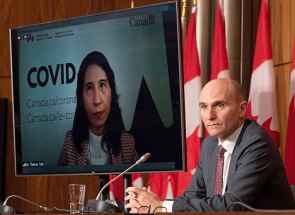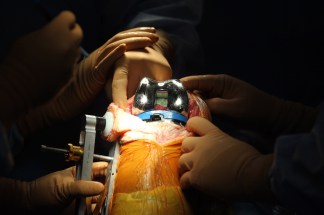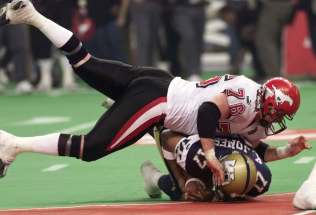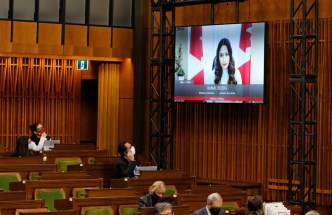Places, everyone! Enter, stage left… The past month has taken Royal Manitoba Theatre Centre from chaos to catharsis as actors and staff behind the scenes worked feverishly to bring the season-opening production to life following a 21-month pandemic shutdown.
Read this article for free:
or
Already have an account? Log in here »
To continue reading, please subscribe:
Monthly Digital Subscription
$0 for the first 4 weeks*
- Enjoy unlimited reading on winnipegfreepress.com
- Read the E-Edition, our digital replica newspaper
- Access News Break, our award-winning app
- Play interactive puzzles
*No charge for 4 weeks then price increases to the regular rate of $19.00 plus GST every four weeks. Offer available to new and qualified returning subscribers only. Cancel any time.
Monthly Digital Subscription
$4.75/week*
- Enjoy unlimited reading on winnipegfreepress.com
- Read the E-Edition, our digital replica newspaper
- Access News Break, our award-winning app
- Play interactive puzzles
*Billed as $19 plus GST every four weeks. Cancel any time.
To continue reading, please subscribe:
Add Free Press access to your Brandon Sun subscription for only an additional
$1 for the first 4 weeks*
*Your next subscription payment will increase by $1.00 and you will be charged $16.99 plus GST for four weeks. After four weeks, your payment will increase to $23.99 plus GST every four weeks.
Read unlimited articles for free today:
or
Already have an account? Log in here »
Hey there, time traveller!
This article was published 26/11/2021 (1480 days ago), so information in it may no longer be current.
It’s been hard times for John Hirsch and Tom Hendry.
The founders of the Royal Manitoba Theatre Centre — or at least their bronze likenesses that stand at the entrance to the theatre at Market Avenue and Lily Street — have welcomed theatre-goers while withstanding blazing sunshine and blinding snowstorms with their gazes of wonder and fascination intact.
The statue seat beside them, and the 785 others inside the John Hirsch Mainstage, have been unoccupied for the past 21 months. The only visitors they greeted were pranksters who placed medical masks over their noses and mouths, an amusing blip of comedy during the tragedy of the COVID-19 pandemic.
But they had plenty of company Thursday night when the theatre’s marquee lit up once again and ticketholders returned to Winnipeg’s largest theatre company for the opening of Orlando, RMTC’s first new play since March 2020.
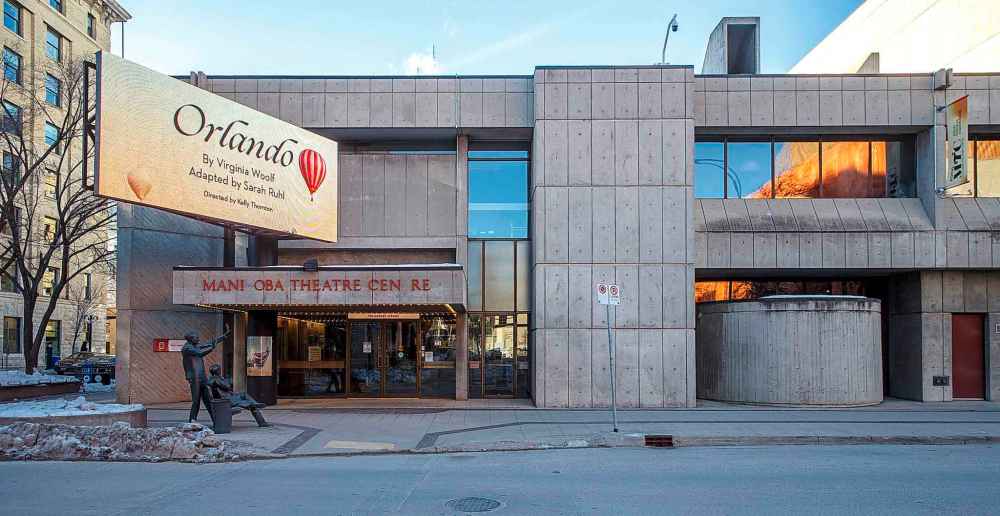
The Free Press has marked this occasion by following the production from the beginning to the final dress rehearsal, going behind the scenes to learn how carpenters, painters, costume designers, tailors, wig-makers, stage managers, directors and actors have brought the company back to the stage after the lengthy shutdown.
During a whirlwind month, the company has emerged from its chrysalis to offer two hours for patrons to escape from reports of fluctuating case numbers, vaccination rates and hospital admissions.
“There’s endless invention and surprise, where things come literally out of nowhere,” says Kelly Thornton, Royal MTC’s artistic director, who finally gets to show Winnipeg her directorial talents after taking over the job a few months before the virus changed everything.
Wonder and fascination remain as strong as ever amid the pandemic adaptations and restrictions the company has worked with.
Hendry and Hirsch would approve.
CEREMONY AND CIRCUMSPECTION
Monday, Oct. 25, 10 a.m.
Thornton let out a deep sigh that could be heard throughout the theatre.
“Welcome back,” she said, looking as if a weight had been lifted from her shoulders.

Her response to returning to work would have been far too dramatic for most workplaces. At the Royal Manitoba Theatre Centre drama seeps from every pore in the concrete building, from the stage to the seats, from its workshops to the wardrobe department.
One month from now, Nov. 25, is opening night of Orlando, and it will mark the end of 626 days without live theatre at the John Hirsch Mainstage.
A dramatic pause indeed.
● ● ●
At the beginning of theatre productions, a meet-and-greet of sorts takes place, in which those involved introduce themselves and their role in making the show a success. Actors, set designers, costumers, carpenters and accountants all take their turn, including Camilla Holland, the company’s executive director. They all have something at stake, be it the next role in their acting career or a regular paycheque.
It’s part ritual, part routine, and it ordinarily takes place in the the company’s rehearsal room.
There is rarely room for ordinary in the theatre though, especially in 2021, and especially during a pandemic.
One of the measures to keep COVID-19 from calling a halt to Royal MTC’s upcoming 26-show run of Orlando means that instead of everyone crowding into the rehearsal room, the introduction takes place in the mainstage itself, with 30 members of the cast and crew on “the deck” — theatre parlance for the stage — and 30 members of the Royal MTC staff “in house,” in the seats, spaced apart among a couple of dozen rows where the audience sits.

“That’s what it takes to put on a play with six actors,” Holland says, after urging everyone to maintain their distance.
COVID-19 preventative measures, such as mask use and being fully vaccinated against the virus, are part of the script, but it also includes keeping Orlando’s actors separated — as much as possible — from others in the production. The show must go on.
The grander location for the intro creates a ceremonial atmosphere, and an actual ceremony makes it official.

Albert McLeod, a Cree elder from Nisichawayasihk First Nation, near Norway House, performs an invocation, smudging and directing sacred smoke north, south, east and west to spirits looking on.
McLeod has a another role in Orlando. The longtime advocate for two-spirit people and HIV/AIDS activist in Manitoba is one of four gender consultants in the production.
Orlando was adapted by American playwright Sarah Ruhl from the Virginia Woolf novel, Orlando: A Biography, which is about the adventures of a a poet who lives for centuries and changes gender several times while doing so.
Thornton took over as artistic director in 2019 and was to direct The Sound of Music in 2020 before the pandemic stepped in.
So Orlando becomes her directorial debut at Royal MTC, and she ends the introductions with a speech, a pre-game pep talk that reminds everyone the hard work is about to begin.

Woolf wrote Orlando: A Biography in 1928, Thornton begins, saying it was one year after women got the vote, one year before the stock-market crash and two years before Royal MTC co-founder John Hirsch was born.
“The sweet spot at the height of the Roaring ’20s,” she said. “This story travels through time but never ages.”
A PowerPoint presentation — another concession to the pandemic — displays on a screen on stage the set drawings, which include a revolve, 7.3 metres in diameter, that rotates like a turntable to quickly change the scenes. It’s a piece of stagecraft that is almost as old as theatre itself.
The big reveal comes from costume designer Leanne Foley, who shows drawings of the lavish clothes the six actors will wear. They gowns re-create the fashions from 16th century to Woolf’s heyday in the 1920s, but Foley adds there will still be room for rock ‘n’ roll clothes horses such as Elton John and Freddie Mercury.
After the introduction, visits to the company’s backstage workshop where carpenters, painters and props creators had already created many of the key items of the show.

Pandemic-alert signs are everywhere and so are signs of how difficult it can be to put on a play while following physical distancing. The props studio, for instance, is a small space and while the Royal MTC building is a fine example of the city’s brutalist architecture, there is no give in the concrete to create extra room for workers to manoeuvre.
Pandemic restrictions allow for only 20 people in the rehearsal room for the first read-through, and that number is quickly reached. There is no room for interlopers.
A glimpse from the stage manager’s office, which has a window overlooking the rehearsal room, is enough to notice the optimism among Orlando’s cast and crew. There’s a month of hard work ahead.
When the curtain rises on Orlando and a new season and a new era for the Royal Manitoba Theatre Centre begins, the tears that will flow will be the real thing, not an actor’s trick.
MAGIC IS A TEAM SPORT
It takes 12 headdresses and hats, eight wigs and 33 wardrobe transformations to look the part in Orlando.
At least that was the number on Nov. 19, six days before opening night. Leanne Foley, the show’s costume designer, prepared for more.

Foley and the Royal Manitoba Theatre Centre’s tailors, led by Thora Lamont, the head of wardrobe, were sewing, cutting and pinning together costumes in preparation for dress rehearsals. Their work will cover five centuries of world history that Orlando, the play’s protagonist, travels: from the lavish gowns of the 1500s to the austere Victorian era of the 19th century to the Roaring ‘20s in the 20th century.

And those wardrobe transitions often are done with same garment, or at least parts of it.
The pièce de resistance may be the elaborate costume the queen — Elizabeth I — wears when she makes a grand entrance.
The colour purple was reserved for royals during the Elizabethan era; the queen wears a regal skirt that later becomes a bedspread and other wardrobe and set accessories.
Her glittery standard, which gives her the larger-than-life presence her standing demands, is the work of designers and craftspeople, and it, too, transforms into other items, including the headboard of her bed.
Something so lavish began with modest ambitions.

“The standard began as the queen’s collar. Queen Elizabeth wore the big collars. The audience will see it as part of the queen’s costume when she comes on stage,” Foley says.
“The queen will come down the steps and the standard will be detached from her costume and it becomes the standard that takes the queen to her boudoir.”

Making the standard is truly a team effort, requiring power drills and lacy frills. The props department took eight machined arms of aluminum, each end adorned with heraldic fleur-de-lis, which create a relatively lightweight structure. The wardrobe department sewed layers of delicate fabric that are draped around the aluminum pieces and the lighting department affixed tiny LEDs to it as well, cleverly concealed by violet petals.
Simon Miron, who plays the queen, in addition to being one of the four members of the the play’s ever-present chorus, has the task of being the standard-bearer.
“It’s taken a while to figure out because it’s such a stunning piece but it also has complex parts in it,” Miron says. “The standard is this very gorgeous and flashy item that transforms several times. It not only is there as an esthetic element, it also supports other elements.”

Men have played women and women have played men throughout theatre’s history. The queen is just another character for Miron to play, but adjusting to 16th-century fashion quirks such as a rigid, underskirt farthingale, and the physical restrictions it creates has been a learning experience.

“She’s always very held and very controlled and very positioned,” Miron says. “That’s really helped me to understand what it’s like to be in this very tight box of always being under scrutiny even though you are the monarch, you are in charge of all things.”
Orlando is Foley’s debut with the Royal MTC backstage team, although she’s a familiar face in the city’s arts community. Besides designing costumes on Manitoba Theatre for Young People shows such as Seussical and A Year with Frog and Toad as well as Winnipeg Jewish Theatre productions, she was also an administrator for 10 years, until 2019, with the Manitoba Arts Council.
She’s seen how the queen’s standard looks under the lights of the John Hirsch Mainstage, and she can’t wait to see how the audience, deprived of live theatre for so long, will react to Orlando and its costumes.

“When you see it under these lights (of the backstage workshop) it looks like some fabric draped on it with twinkie lights,” she says, “but on stage… (lighting designer) Hugh Conacher doing his magic and the actors doing their magic, everybody coming together, the sound and the video, it looks (like) a million dollars.
“That’s the magic of the theatre. That’s our craft.”
TALENT TRANSFORMS THE CHAOS
Thursday, Oct. 28, rehearsal hall, John Hirsch Mainstage
In theatre, it’s the early hours in the rehearsal hall, long before any fancy duds are donned, when the talent reveals itself.
This is one of those days.

Actors Em Siobhan McCourt, Simon Miron, Simon Bracken, Ivy Charles and Breton Lalama — all wearing masks — rehearse the opening moments of Orlando.
McCourt plays the title role, and as the play opens, Orlando is a teenager torn between swordsmanship and artistic pursuits, such as poetry. Miron, Bracken, Charles and Lalama play the Chorus, four people who narrate and depict scenery, all the while moving about furniture on the stage, part and parcel of story theatre, a style that Orlando uses.
This was supposed to be a read-through, but the early creation of “the cake” — a wooden part of the set that has three tiers, is 3.6 metres in diameter, splits into four pieces and can be moved easily and silently — allows for more than just working on lines.
It’s easy to forget about movement when watching a play because the words and how they’re spoken are attention-getters. But actors don’t just stand anywhere and recite their lines. There’s a purpose for every position they take, and even when they appear to be strolling on the stage, the speed and direction of their wandering is all planned.
An actor’s interaction with others and with props or furniture adds a whole extra layer of complexity.

“Often people think about the performers because that’s what you see, but the incredible amount of work to make these things happen is shocking,” Miron says. “To share that artistry with other human beings, in person, is such an X-factor.”
Perhaps the most important part of this set is the revolve, a turning part of the stage that is 12 metres in diameter, which is represented on this day by a a neon-orange piece of tape in the shape of a circle in the middle of the hall.
The actors remember where they need to be for a certain moment, but when the revolve turns, getting to that spot on the stage might mean more or fewer steps, plus watching out for other actors and furniture that could get in the path.

Plus, there is no revolve in the rehearsal hall. Every move has to be imagined, and the large slice of cake is moved by stage managers to mimic the turning of the revolve.
That aspect creates some confusion and some unintentional comedy — should it turn clockwise or counter-clockwise? — but it’s quickly sorted out.
Mistakes are made, lines are forgotten — it is only Day 4 of a month-long process — but there are no giggles and no angry words exchanged.
Beyond all the COVID-19 protocols posted on the rehearsal-room walls are three large sheets of paper titled “Room agreement.” Included is safety advice for both physical and emotional well-being, as well as mentions of open dialogue, consent, respecting privacy and using the chosen pronouns of fellow cast and crew members.

One sentence ought be posted in every workplace and on social media websites: “Make mistakes without judgment.”
At the end of the two-hour session, during which Thornton cuts in occasionally to advise the actors about major and tiny details of their parts, she tells them to run through of the first three minutes of Orlando.
The transformation from organized chaos to a rough draft of theatre is remarkable. It shows why these actors, the people picked specifically for Orlando, were chosen.
It’s a pretty good first-time run-through of the play’s opening few minutes, and Thornton applauds, saying it requires only a bit more polish.
It all comes together like magic, but every magician says there is talent behind every trick, and practice creates that talent.
PANDEMIC PRODUCTION

When Robert Kirby designed the Royal Manitoba Theatre Centre, no one would have imagined how it would adapt to a pandemic.
The 51-year-old building is already a Parks Canada national historic site, with reinforced concrete being the hallmark of brutalist architecture.

A Parks Canada plaque mentions its “innovative use of space and light in the foyer, auditorium and backstage areas creates an intimate atmosphere and supports artistic and technical collaboration.”
A backstage tour in the days leading up to its production of Orlando shows how innovative and intimate it is, and how those features have posed some challenges for the theatre company as its resumes production in the midst of COVID-19 concerns.
The rehearsal room is tall and spacious, but pandemic regulations keep capacity to 20 people, so actors not working on a scene are asked to stay away. It’s one of the logistical reasons why Orlando, with just six actors in the cast, was chosen to lead off RMTC’s season.

There’s lots of room backstage where carpenters and painters work on a puppet-theatre backdrop or a mast for a sailing-ship scene.
Add a few workers from wardrobe and props and a couple of onlookers, however, and it becomes a little more challenging to maintain the recommended two metres of physical distance, but everyone is aware so… so far, so good.
A visit to the long and narrow props room would earn a few “excuse me” utterances long before COVID-19 protocols became necessary. In November 2021, moving around the space is a lesson in pandemic choreography and keeping visitors, even within the company, to a minimum.
Similar guidelines apply in the small studios where Beverley Covert, Royal MTC’s head of wigs and makeup, builds wiry cages made to fit actors’ heads. She then attaches hair — real hair — into Elizabethan hairpieces that transport Orlando to the 16th century.

Global supply-chain issues have affected many things, including hair.
“What you think you buy isn’t always what you get,” Covert says.
The RMTC building has a labyrinth of concrete corridors and stairways that reveal one of the challenges the company and its staff face during the pandemic. People are flexible. Concrete is not.

EMOTIONAL, FINANCIAL BOOST
Tuesday, Nov. 23, Royal MTC lobby
The notes from the new ticket scanner were music to the ears to audience members, volunteer ushers and RMTC’s front-of-house staff.
Tuesday was a dress rehearsal for Orlando, and about 50 volunteers who will assist audience members during the production that runs until Dec. 18 were getting a sneak peek of the show two days before its official première.
It also allowed RMTC staff an opportunity to see how the transformation of its lobby and other changes it made to adapt to COVID-19 pandemic restrictions have worked out.
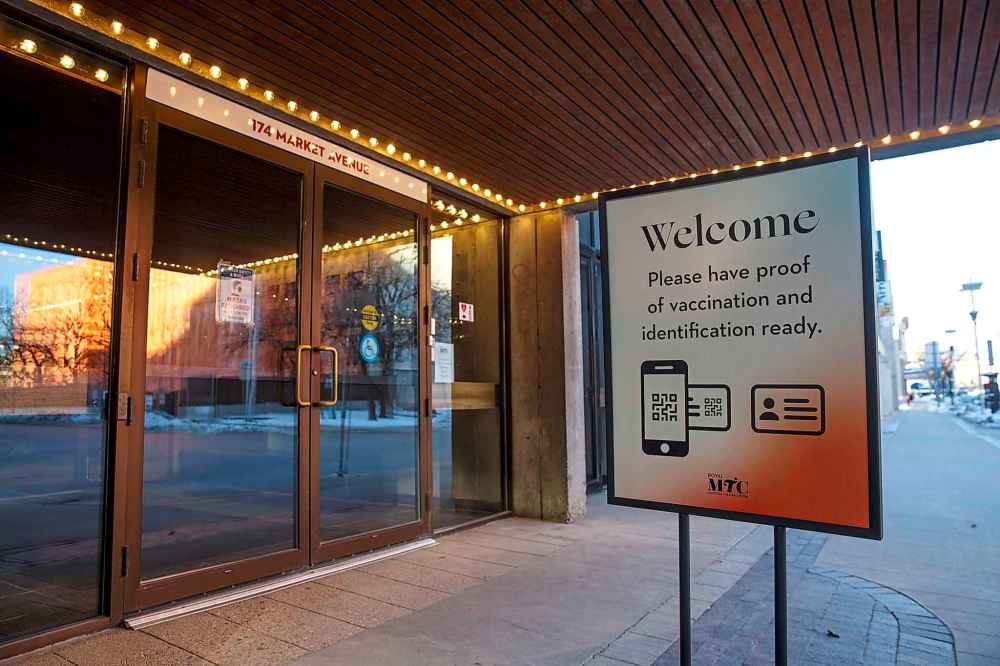
“There are tweaks we need to make, like extra signs, extra bodies, extra sanitizers,” says Sheena Baird, the company’s director of patron services. “People are really excited about the addition of these mobile tickets.”
Baird says audience members had asked for electronic ticket entry for its shows before the pandemic and that feature is among the many changes people will notice this season.
The pandemic forced the theatre company to close its doors to live audiences in March 2020, and the 21 months since has allowed it to reconsider everything it does.
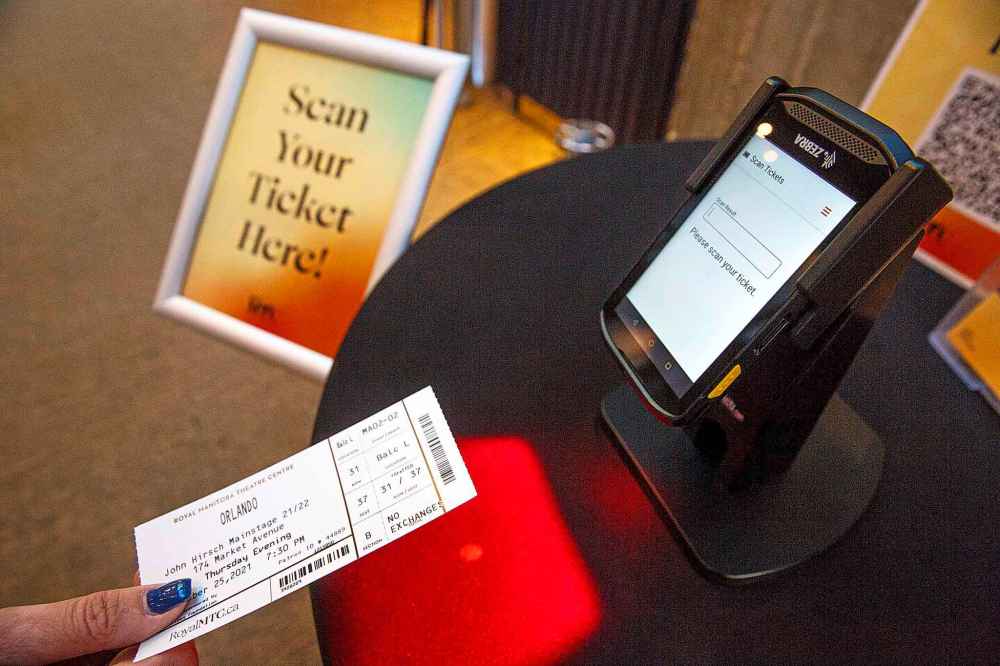
Firstly, staff and actors are double-vaccinated against COVID-19, and the cast undergoes regular rapid-antigen testing to make sure the show goes on, and goes on safely.
“There’s always an undercurrent of, ‘What happens if we can’t keep them safe? What if someone gets sick? How do we keep the audience safe?’” Thornton says. “All the mechanics of getting this onto the stage is more than just, ‘We’ll direct all the scenes and then we’ll make brilliant transitions and go before an audience and Bob’s your uncle.’ There’s an ongoing (theme) that is safety, safety, safety.”
That safety begins when people first walk in. The box office has moved from the small vestibule just inside the doors to inside the lobby, where there’s more room. The entrance has always been a crowded spot where people meet up, purchase and pick up tickets.
Masks must be worn when not eating or drinking and Plexiglas separates bartenders from ticketholders when they purchase drinks or snacks.
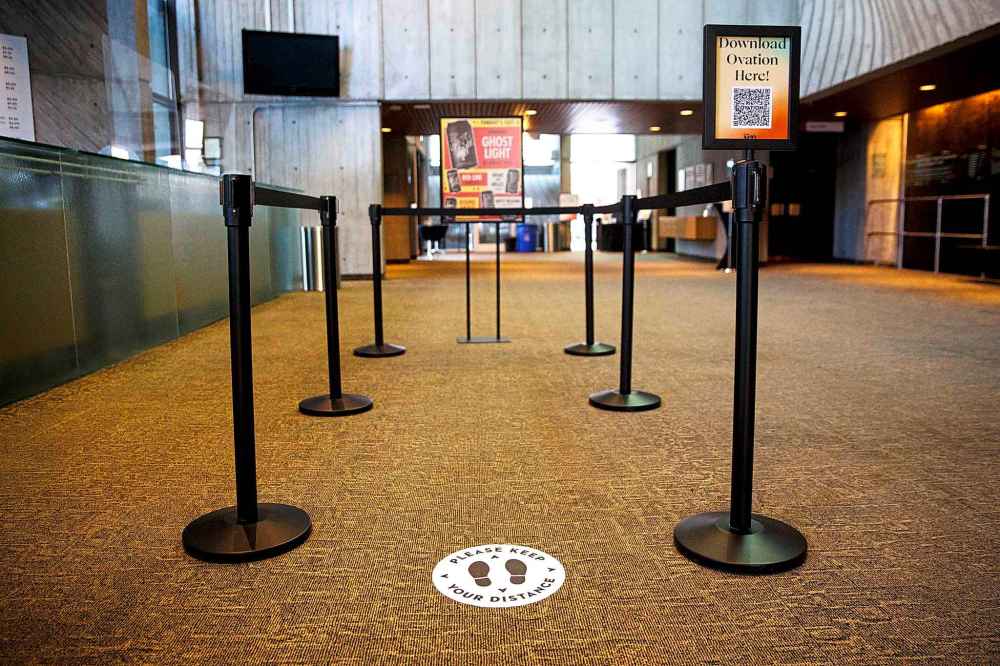
Provincial health regulations allow the company to sell all the seats for its shows, but for now, the company is selling only 400 seats, about half-capacity for performances of Orlando, following the lead of other arts groups that have already held live shows, such as the Winnipeg Symphony Orchestra and Royal Winnipeg Ballet.
Not only does it keep people spaced apart in the seats, it provides more room in other places where people gather, such as the bar, washrooms and coat-check areas.
Feeling the excitement of people returning for a show at the RMTC has been an emotional boost, Baird says, but getting back to the business of show business will be a financial one for staff too, some of whom were laid off when the theatre went dark.
“It actually feels familiar in a lot of ways because we’re so used to having people coming in and out of our doors,” she says. “Our audience tonight are volunteers. The number of people who have raised their hands to come back have filled our hearts.
“Not to be cheesy, but that’s how it feels.”
Alan.Small@winnipegfreepress.com
Twitter: @AlanDSmall












Alan Small has been a journalist at the Free Press for more than 22 years in a variety of roles, the latest being a reporter in the Arts and Life section.

Mike Deal started freelancing for the Winnipeg Free Press in 1997. Three years later, he landed a part-time job as a night photo desk editor.
Our newsroom depends on a growing audience of readers to power our journalism. If you are not a paid reader, please consider becoming a subscriber.
Our newsroom depends on its audience of readers to power our journalism. Thank you for your support.



